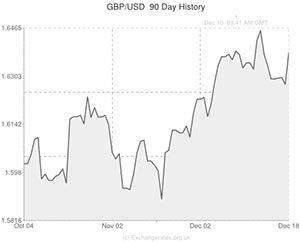
After months of speculation the Federal Reserve finally decided to taper its asset purchasing scheme last night. The US Central Bank announced that it will be reducing its monthly purchases from $85 billion per month down to $75 billion per month due to improvements in the labour market. The $10 billion taper will consist of an equal $5 billion reduction to both mortgage-backed securities and US Treasuries.
Surprisingly, the Pound to US Dollar exchange rate actually rallied after the announcement, briefly striking a fresh 27-month high of 1.6485.
There are two reasons for GBP/USD’s unexpected jump.
Firstly, Federal Reserve Chairman Ben Bernanke used his post-decision press conference to try and hammer home the point that “tapering does not equal tightening”, probably in attempt to assuage fears that credit conditions in America could worsen following the decision, which could leave the Federal Reserve’s hopes of an economic revival hoisted by its own petard. The special effort that Bernanke put into convincing markets that the taper would not lead to higher interest rates was seen as dovish by traders, and this worked against the US Dollar.
And secondly, earlier in the day yesterday it was announced that the British Unemployment Rate fell by -0.2% to a fresh 4.5-year low of 7.4%. A surprisingly high 250,000 people found work in the run up to October and this sent the total number of people in employment in Britain up to an all-time high of just over 30 million. The latest optimistic labour market reading means that the headline UK Unemployment Rate is currently just four percentage points above the Bank of England’s 7.0% threshold – a level which is likely to bring about a hiking of interest rates from the Central Bank.
A combination of the Fed’s dovish speak in the immediate aftermath of the taper and the UK’s sanguine labour market prospects led investors to the conclusion that the BoE will hike rates before the Fed, and this is what sent GBP/USD higher yesterday evening. On the day, Sterling appreciated by over 2.5 cents.
A similar, but slightly different, mindset allowed the Pound to reach a fresh 4-year high against the Australian Dollar. The primary driver behind GBP/AUD’s electric 3-cent ascent, from 1.8280 to 1.8530, was the unexpectedly robust UK labour market report.
However, despite Bernanke’s dovish undertones, and the recognition that asset purchases are likely to continue, albeit at a reduced pace, for the entirety of 2014, the tapering of QE3 had a negative impact on the high-risk ‘Aussie’ Dollar. This is because the Australian Dollar is highly perceptible to shifts in risk sentiment. By reducing asset purchases, which in essence is making credit more expensive, the Fed’s decision to taper QE3 made investors less keen to hold assets priced in AUD that are liable to fluctuate in value.

Comments are closed.